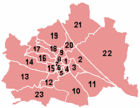|
Vienna
Vienna (/viˈɛnə/ ⓘ vee-EN-ə;[8][9] German: Wien [viːn] ⓘ; Austro-Bavarian: Wean [veɐ̯n]) is the capital, most populous city, and one of nine federal states of Austria. It is Austria's primate city, with just over two million inhabitants.[10][11] Its larger metropolitan area has a population of nearly 2.9 million,[12] representing nearly one-third of the country's population. Vienna is the cultural, economic, and political center of the country, the fifth-largest city by population in the European Union, and the most-populous of the cities on the Danube river. The city lies on the eastern edge of the Vienna Woods (Wienerwald), the northeasternmost foothills of the Alps, that separate Vienna from the more western parts of Austria, at the transition to the Pannonian Basin. It sits on the Danube, and is traversed by the highly regulated Wienfluss (Vienna River). Vienna is completely surrounded by Lower Austria, and lies around 50 km (31 mi) west of Slovakia and its capital Bratislava, 60 km (37 mi) northwest of Hungary, and 60 km (37 mi) south of Moravia (Czech Republic). The once Celtic settlement of Vedunia was converted by the Romans into the castrum Vindobona (province of Pannonia) in the 1st century, and was elevated to a municipium with Roman city rights in 212. This was followed by a time in the sphere of influence of the Lombards and later the Pannonian Avars, when Slavs formed the majority of the region's population.[a] From the 8th century on, the region was settled by the Baiuvarii. In 1155, Vienna became the seat of the Babenbergs, who ruled Austria from 976 to 1246. In 1221, Vienna was granted city rights. During the 16th century, the Habsburgs, who had succeeded the Babenbergs, established Vienna as the seat of the emperors of the Holy Roman Empire, a position it held until the empire's dissolution in 1806, with only a brief interruption. With the formation of the Austrian Empire in 1804, Vienna became the capital of it and all its successor states. Throughout the modern era, Vienna has been among the largest German-speaking cities in the world. It was the largest in the 18th and 19th century, peaking at two million inhabitants before it was overtaken by Berlin at the beginning of the 20th century.[13][14][15] Vienna is host to many major international organizations, including the United Nations, OPEC and the OSCE. In 2001, the city center was designated a UNESCO World Heritage Site. In July 2017, it was moved to the list of World Heritage in Danger.[16] Vienna has been called the "City of Music"[17] due to its musical legacy, as many famous classical musicians such as Beethoven, Brahms, Bruckner, Haydn, Mahler, Mozart, Schoenberg, Schubert, Johann Strauss I and Johann Strauss II lived and worked there.[18] It played a pivotal role as a leading European music center, from the age of Viennese Classicism through the early part of the 20th century. Vienna was home to the world's first psychoanalyst, Sigmund Freud.[19] The historic center of Vienna is rich in architectural ensembles, including Baroque palaces and gardens, and the late-19th-century Ringstraße, which is lined with grand buildings, monuments, and parks.[20] In 2024, Vienna retained its position as most livable city per the Economist Intelligence Unit, and has spent every year since 2015 in the top 2 places, bar 2021 due to the COVID-19 lockdowns. EtymologyThe place is mentioned as Οϋι[νδ]όβονα (Oui[nd]obona) in the 2nd century AD (Ptolemy, Geography, II, 14, 3); Vindobona in the 3rd century (Itinerarium Antonini Augusti 233, 8); Vindobona in the 4th century (Tabula Peutingeriana, V, 1); Vindomana ab. 400 (Notitia Dignitatum, 145, 16); Vindomina, Vendomina in the 6th century (Jordanes, De origine actibusque Getarum, 50, 264). The English name Vienna is borrowed from the homonymous Italian name. The German name Wien comes from the name of the river Wien, mentioned ad UUeniam in 881 (Wenia- in modern writing).[21][22][23] The name of the Roman settlement on the same emplacement is of Celtic extraction Vindobona, probably meaning "white village, white settlement" from Celtic roots, vindo-, meaning "white" (Old Irish find "white", Welsh gwyn / gwenn, Old Breton guinn "white, bright" > Breton gwenn "white"), and -bona "foundation, settlement, village",[24][25] related to Old Irish bun "base, foundation" and Welsh bon, same meaning.[25] The Celtic word vindos may reflect a widespread prehistorical cult of Vindos, a Celtic deity who survives in Irish mythology as the warrior and seer Fionn mac Cumhaill.[26][27] A variant of this Celtic name could be preserved in the Czech, Slovak, Polish and Ukrainian names of the city (Vídeň, Viedeň, Wiedeń and Відень respectively) and in that of the city's district Wieden.[28] The name of the city in Hungarian (Bécs), Serbo-Croatian (Beč, Беч) and Ottoman Turkish (بچ, Beç) has a different, probably Slavonic origin, and originally referred to an Avar fort in the area.[29] Slovene speakers call the city Dunaj, which in other Central European Slavic languages means the river Danube, on which the city stands. HistoryHistorical affiliations
Roman periodIn the 1st century, the Romans set up the military camp of Vindobona in Pannonia on the site of today's Vienna city center near the Danube with an adjoining civilian town to secure the borders of the Roman Empire. Construction of the legionary camp began around 97 AD. At its peak, Vindobona had a population of around 15,000 people. It was a part of a trade and communications network across the Empire. Roman emperor Marcus Aurelius may have died here in 180 AD during a campaign against the Marcomanni. After a Germanic invasion in the second century the city was rebuilt. It served as a seat of the Roman government until the fifth century, when the population fled due to the Huns invasion of Pannonia. The city was abandoned for several centuries. Evidence of the Romans in the city is plentiful. Remains of the military camp have been found under the city, as well as fragments of the canal system and figurines. Middle AgesClose ties with other Celtic peoples continued through the ages. The Irish monk Saint Colman (or Koloman, Irish Colmán, derived from colm "dove") is buried in Melk Abbey and Saint Fergil (Virgil the Geometer) served as Bishop of Salzburg for forty years. Irish Benedictines founded twelfth-century monastic settlements; evidence of these ties persists in the form of Vienna's great Schottenstift monastery (Scots Abbey), once home to many Irish monks. In 976, Leopold I of Babenberg became count of the Eastern March, a district centered on the Danube on the eastern frontier of Bavaria. This initial district grew into the duchy of Austria. Each succeeding Babenberg ruler expanded the march east along the Danube, eventually encompassing Vienna and the lands immediately east. In 1155, Henry II, Duke of Austria moved the Babenberg family residence with the founding of the Schottenstift from Klosterneuburg in Lower Austria to Vienna.[30] From that time, Vienna remained the center of the Babenberg dynasty.[31] Hungary occupied the city between 1485 and 1490.  Vienna became at the turn to the 16th century the seat of the Aulic Council[32] and subsequently later in the 16th century of the Habsburg emperors of the Holy Roman Empire with an interruption between at the turn to the 17th century until 1806, becoming an important center in the empire.[33] In the 16th and 17th centuries, Christian forces twice stopped Ottoman armies outside Vienna, in the 1529 siege of Vienna and the 1683 Battle of Vienna. The Great Plague of Vienna ravaged the city in 1679, killing nearly a third of its population.[34]  Austrian Empire and early 20th centuryIn 1804, during the Napoleonic Wars, Vienna became the capital of the newly formed Austrian Empire. The city continued to play a major role in European and world politics, including hosting the Congress of Vienna in 1814–15. The city also saw major uprisings against Habsburg rule in 1848, which were suppressed. After the Austro-Hungarian Compromise of 1867, Vienna remained the capital of what became the Austro-Hungarian Empire. The city functioned as a center of classical music, for which the title of the First Viennese School (Haydn/Mozart/Beethoven) is sometimes applied. 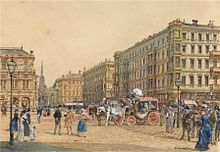 During the latter half of the 19th century, Vienna developed what had previously been the bastions and glacis into the Ringstraße, a new boulevard surrounding the historical town and a major prestige project. Former suburbs were incorporated, and the city of Vienna grew dramatically. In 1918, after World War I, Vienna became capital of the Republic of German-Austria, and then in 1919 of the First Republic of Austria. From the late-19th century to 1938, the city remained a center of high culture and of modernism. A world capital of music, Vienna played host to composers such as Johannes Brahms, Anton Bruckner, Gustav Mahler, and Richard Strauss. The city's cultural contributions in the first half of the 20th century included, among many, the Vienna Secession movement in art, the Second Viennese School, the architecture of Adolf Loos, the philosophy of Ludwig Wittgenstein, and the Vienna Circle. Red Vienna The city of Vienna became the center of socialist politics from 1919 to 1934, a period referred to as Red Vienna (Das rote Wien). After a new breed of socialist politicians won the local elections they engaged in a brief but ambitious municipal experiment.[35] Social democrats had won an absolute majority in the May 1919 municipal election and commanded the city council with 100 of the 165 seats. Jakob Reumann was appointed by the city council as city mayor.[36] The theoretical foundations of so-called Austromarxism were established by Otto Bauer, Karl Renner, and Max Adler.[37] Red Vienna is perhaps most well known for its Gemeindebauten, public housing buildings. Between 1925 and 1934, over 60,000 new apartments were built in the Gemeindebauten. Apartments were assigned on the basis of a point system favoring families and less affluent citizens.[38] July Revolt and Civil War In July 1927, after three nationalist far-right paramilitary members were acquitted of the killing of two social democratic Republikanischer Schutzbund members, a riot broke out in the city. The protestors, enraged by the decision, set the Palace of Justice ablaze. The police attempted to end the revolt with force and killed at least 84 protestors, with 5 policemen also dying.[39] In 1933, right-wing Chancellor Engelbert Dollfuss dissolved the parliament, essentially letting him run the country as a dictatorship, banned the Communist Party and severely limited the influence of the Social Democratic Party. This led to a civil war between the right-wing government and socialist forces the following year, which started in Linz and quickly spread to Vienna. Socialist members of the Republikanischer Schutzbund barricaded themselves inside the housing estates and exchanged fire with the police and paramilitary groups. The fighting in Vienna ended after the Austrian Armed Forces shelled the Karl-Marx-Hof, a civilian housing estate, and the Schutzbund surrendered.[40] Anschluss and World War II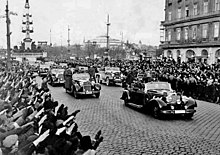 On 15 March 1938, three days after German troops had first entered Austria, Adolf Hitler arrived in Vienna. 200,000 Austrians greeted him at the Heldenplatz, where he held a speech from a balcony in the Neue Burg, in which he announced that Austria would be absorbed into Nazi Germany. The persecution of Jews started almost immediately, Viennese Jews were harassed and hounded, their homes and businesses plundered. Some were forced to scrub pro-independence slogans off the streets. This culminated in the Kristallnacht, a nationwide pogrom against the Jews carried out by the Schutzstaffel and the Sturmabteilung, with support of the Hitler Youth and German civilians. All synagogues and prayer houses in the city were destroyed, bar the Stadttempel, due to its proximity to residential buildings.[41][42] Vienna lost its status as a capital to Berlin, as Austria had ceased to exist. The few resistors in the city were arrested. Adolf Eichmann held office in the expropriated Palais Rothschild and organized the expropriation and persecution of the Jews. Of the almost 200,000 Jews in Vienna, around 120,000 were driven to emigrate and around 65,000 were killed. After the end of the war, the Jewish population of Vienna was only about 5,000.[43][44][45][46]  In 1942 the city suffered its first air raid, carried out by the Soviet air force. Only after the Allies had taken Italy did the next raids commence. From 17 March 1944, 51 air raids were carried out in Vienna. Targets of the bombings were primarily the city's oil refineries. However, around a third of the city center was destroyed, and culturally important buildings such as the State Opera and the Burgtheater were burned, and the Albertina was heavily damaged. These air raids lasted until March 1945, just before the Soviet troops started the Vienna offensive. The Red Army, who had previously marched through Hungary, first entered Vienna on 6 April. They first attacked the eastern and southern suburbs, before moving on to the western suburbs. By the 8th they had the center of the city surrounded. The following day the Soviets started with the infiltration of the city center. Fighting continued for a few more days until the Soviet Navy’s Danube Flotilla naval force arrived with reinforcements. The remaining defending soldiers surrendered that same day.  Four-power Vienna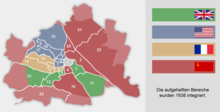 After the war, Vienna was part of Soviet-occupied Eastern Austria until September 1945. That month, Vienna was divided into sectors by the four powers: the US, the UK, France, and the Soviet Union and supervised by an Allied Commission. The four-power occupation of Vienna differed in one key respect from that of Berlin: the central area of the city, known as the first district, constituted an international zone in which the four powers alternated control on a monthly basis. The city was policed by the four powers on a day-to-day basis using the "four soldiers in a jeep" method, which had one soldier from each nation sitting together. The four powers all had separate headquarters, the Soviets in Palais Epstein next to the Parliament, the French in Hotel Kummer on Mariahilferstraße, the Americans in the National Bank, and the British in Schönnbrunn Palace. The division of the city was not comparable to that of Berlin. Although the borders between the sectors were marked, travel between them was freely possible. During the ten years of the four-power occupation, Vienna was a hotbed for international espionage between the Western and Eastern blocs, which deeply distrusted each other. The city experienced an economic upturn due to the Marshall Plan. The atmosphere of four-power Vienna is the background for Graham Greene's screenplay for the film The Third Man (1949). The film's theme music was composed and performed by Viennese musician Anton Karas using a zither. Later he adapted the screenplay as a novel and published it. Occupied Vienna is also depicted in the 1991 Philip Kerr novel, A German Requiem. Austrian State Treaty and subsequent sovereignty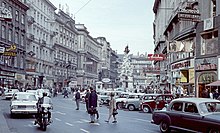 The four-power control of Vienna lasted until the Austrian State Treaty was signed in May 1955 and came into force on 27 July 1955. By October, all soldiers had left the country. That year, after years of reconstruction and restoration, the State Opera and the Burgtheater, both on the Ringstraße, reopened to the public. In the Autumn of 1956, Vienna accepted many Hungarian refugees, who had fled Hungary after an attempted revolution. The city experienced another wave of refugees after the Prague Spring in Czechoslovakia in 1968, as well as after the collapse of Yugoslavia in 1991. In 1972 the construction of the Donauinsel and the excavation of the New Danube began. In the same decade, Austrian Chancellor Bruno Kreisky inaugurated the Vienna International Centre, a new area of the city created to host international institutions. Vienna has regained much of its former international stature by hosting international organisations, such as the United Nations. Demographics
Because of the industrialization and migration from other parts of the Empire, the population of Vienna increased sharply during its time as the capital of Austria-Hungary (1867–1918). In 1910, Vienna had more than two million inhabitants and was the third largest city in Europe after London and Paris.[49] Around the start of the 20th century, Vienna was the city with the second-largest Czech population in the world (after Prague).[50] After World War I, many Czechs and Hungarians returned to their ancestral countries, resulting in a decline in the Viennese population. After World War II, the Soviets used force to repatriate key workers of Czech, Slovak and Hungarian origins to return to their ethnic homelands to further the Soviet bloc economy.[citation needed] The population of Vienna generally stagnated or declined through the remainder of the 20th century, not demonstrating significant growth again until the census of 2000. In 2020, Vienna's population remained significantly below its reported peak in 1916. Under the Nazi regime, 65,000 Jews were deported and murdered in concentration camps by Nazi forces; approximately 130,000 fled.[51] By 2001, 16% of people living in Austria had nationalities other than Austrian, nearly half of whom were from former Yugoslavia;[52][53] the next most numerous nationalities in Vienna were Turks (39,000; 2.5%), Poles (13,600; 0.9%) and Germans (12,700; 0.8%). As of 2012[update], an official report from Statistics Austria showed that more than 660,000 (38.8%) of the Viennese population have full or partial migrant background, mostly from Ex-Yugoslavia, Turkey, Germany, Poland, Romania and Hungary.[11][54] From 2005 to 2015 the city's population grew by 10.1%.[55] According to UN-Habitat, Vienna could be the fastest growing city out of 17 European metropolitan areas until 2025 with an increase of 4.65% of its population, compared to 2010.[56]
ReligionReligion in Vienna (2021)[58] Unaffiliated (34%) Catholic Church (32%) Eastern Orthodoxy (11%) Islam (15%) Other (8%)
According to the 2021 census, 49.0% of Viennese were Christian. Among them, 31.8% were Catholic, 11.2% were Eastern Orthodox, and 3.7% were Protestant, mostly Lutheran, 34.1% had no religious affiliation, 14.8% were Muslim, and 2% were of other religions, including Jewish.[59] One sources estimates that Vienna's Jewish community is of 8,000 members meanwhile another suggest 15,000.[60][61] Based on information provided to city officials by various religious organizations about their membership, Vienna's Statistical Yearbook 2019 reports in 2018 an estimated 610,269 Roman Catholics, or 32.3% of the population, and 200,000 (10.4%) Muslims, 70,298 (3.7%) Orthodox, 57,502 (3.0%) other Christians, and 9,504 (0.5%) other religions.[62] A study conducted by the Vienna Institute of Demography estimated the 2018 proportions to be 34% Catholic, 30% unaffiliated, 15% Muslim, 10% Orthodox, 4% Protestant, and 6% other religions.[63][64] As of the spring of 2014, Muslims made up 30% of the total proportion of schoolchildren in Vienna.[65][66] Vienna is the seat of the Metropolitan Roman Catholic Archdiocese of Vienna, in which is also vested the exempt Ordinariate for Byzantine-Rite Catholics in Austria; its Archbishop is Cardinal Christoph Schönborn. Many Catholic Churches in central Vienna feature performances of religious or other music, including masses sung to classical music and organ. Some of Vienna's most significant historical buildings are Catholic churches, including the St. Stephen's Cathedral (Stephansdom), Karlskirche, Peterskirche and the Votivkirche. On the banks of the Danube is a Buddhist Peace Pagoda, built in 1983 by the monks and nuns of Nipponzan Myohoji. Geography Vienna is located in northeastern Austria, at the easternmost extension of the Alps in the Vienna Basin. The earliest settlement, at the location of today's inner city, was south of the meandering Danube while the city now spans both sides of the river. Elevation ranges from 151 to 542 m (495 to 1,778 ft). The city has a total area of 414.78 square kilometers (160.1 sq mi), making it the largest city in Austria by area. ClimateWhereas the higher elevated north/western edges of Vienna have a borderline oceanic (Köppen: Cfb) and humid continental climate (Köppen: Dfb), most parts of the urban core are warm enough for a humid subtropical (Köppen: Cfa) classification with dozens of days exceeding 30 °C (86 °F) and night temperatures not dropping below 20 °C (68 °F). The city has warm to hot showery summers, with average high temperatures ranging between 27 to 32 °C (81 to 90 °F) and a record maximum exceeding 38 °C (100 °F). Winters are relatively dry and cool to cold with daily mean temperatures at or well above freezing point. Spring is variable and autumn cool, with a chance of snow in or after November. Snowfall and frequent frost have become rare though in the last decades, with snow cover mostly ranging from zero to a few inches for a short period of time. Precipitation is generally moderate throughout the year, averaging around 600 mm (23.6 in) annually, with considerable local variations, the Vienna Woods region in the west being the wettest part (700 to 800 mm (28 to 31 in) annually) and the flat plains in the east being the driest part (500 to 550 mm (20 to 22 in) annually). Snow in winter is not common anymore and not so frequent compared to the mostly alpine Western and Southern regions of Austria.
Districts and enlargement Districts Vienna is divided into 23 districts (German: Bezirke). Each district has both a name and a corresponding number. These numbers are displayed on every street sign before the street name (e.g., 16., Thaliastraße). They also serve as the second and third digits of the postcode (1010 for the 1st district to 1230 for the 23rd district). Residents of the districts (Austrians as well as EU citizens) elect the district assembly to a five year term. The elections take place concurrently with the state election. Any decision taken by the district can be overridden by the city assembly or the responsible city councilor.
Enlargement The heart and historical city of Vienna, a large part of today's Innere Stadt, was a fortress surrounded by fields to defend itself from potential attackers. In 1850, with the emperor's consent, Vienna annexed 34 surrounding villages into the city limits. Following this expansion the walls were taken down, allowing the city center to expand.[73] In its place, a broad boulevard called the Ringstraße was built, along which grand public and private buildings, monuments and parks were constructed by the early 20th century. These buildings include the Rathaus, Burgtheater, University, Parliament, the twin museums of natural history and fine art, and the Staatsoper. It is also the location of the New Wing of the Hofburg, the former imperial palace, and the Imperial and Royal War Ministry finished in 1913. The mainly Gothic Stephansdom is located at the center of the city, on Stephansplatz. The Imperial-Royal Government set up the Vienna City Renovation Fund (Wiener Stadterneuerungsfonds) and sold many building lots to private investors, thereby partly financing public construction works. From 1850 to 1890, city limits in the West and the South mainly followed another wall called Linienwall at which a road toll called the Liniengeld was charged. Outside this wall from 1873 onwards a ring road called The Gürtel was built. In 1890 it was decided to integrate 33 suburbs (called Vororte) beyond that wall into Vienna by 1 January 1892[74] and transform them into districts no. 11 to 19 (district no. 10 had been constituted in 1874); hence the Linienwall was torn down beginning in 1894.[75] In 1900, district no. 20, Brigittenau, was created by separating the area from the 2nd district. From 1850 to 1904, Vienna had expanded only on the eastern bank of the Danube, following the main branch before the regulation of 1868–1875, i.e., the Old Danube of today. In 1904, the 21st district was created by integrating Floridsdorf, Kagran, Stadlau, Hirschstetten, Aspern and other villages on the left bank of the Danube into Vienna, and in 1910 Strebersdorf followed. On 15 October 1938, the Nazis created Great Vienna with 26 districts by merging 97 towns and villages into Vienna, 80 of which were returned to surrounding Lower Austria in 1954.[74] Since then Vienna has had 23 districts. Industries are located mostly in the southern and eastern districts. The Innere Stadt is situated away from the main flow of the Danube, but is bounded by the Donaukanal ("Danube canal"). Vienna's second and twentieth districts are located between the Donaukanal and the Danube. Across the Danube, where the Vienna International Centre is located (districts 21–22), and in the southern areas (district 23) are the newest parts of the city. PoliticsPolitical history In the provinces represented in the Imperial Council, men had enjoyed universal suffrage at the national level since 1907. However, Mayor Karl Lueger of the Christian Social Party prevented the adoption of this right to vote in municipal council elections, effectively excluding many working-class people. The first elections in which all adult men and women were entitled to vote took place in 1919, after the end of the monarchy. Since 1919, the Social Democratic Party of Austria (SPÖ) has consistently provided the mayor in all free elections, and the Vienna City Council (the city parliament) has maintained a Social Democratic majority. On 10 November 1920, the Federal Constitution of Austria came into force. This constitution defined Vienna as a separate federal state, enabling its separation from Lower Austria. Since then, the mayor of Vienna has also served as the governor of the state, the city senate has functioned as the state government and the municipal council the state parliament. Vienna continued to serve as the seat of the Lower Austrian government until 1997, when it relocated to St. Pölten. From 1934 to 1945, during the Austrofascist and Nazi periods, no democratic elections were held, and the city was governed under a dictatorship. During this time, the SPÖ was banned, and many of its members were imprisoned. Vienna's city constitution was reinstated in 1945. The city has enacted numerous social democratic policies. One notable example is the Gemeindebauten, social housing assets that are well-integrated into the city's architecture outside the inner district. These low-cost rentals provide comfortable accommodation and good access to city amenities. Many of the projects were built after World War II on vacant lots left by bombings during the war, with a strong emphasis on high construction standards. Today, Vienna's social housing accommodates over 500,000 people.[76] Government In the 1996 City Council election, the SPÖ lost its overall majority in the 100-seat chamber, winning 43 seats and 39.15% of the vote. The SPÖ had previously held an outright majority in every free municipal election since 1919. In the same election, the Freedom Party of Austria (FPÖ) won 29 seats, an increase from 21 in 1991, and surpassed the ÖVP, who finished in third place for the second consecutive election. From 1996 to 2001, the SPÖ governed Vienna in a coalition with the ÖVP. In 2001, the SPÖ regained their overall majority with 52 seats and 46.91% of the vote. In 2005, this majority increased further to 55 seats (49.09%). However, in the 2010 elections, the SPÖ lost their overall majority again and subsequently formed a coalition with the Green Party – the first SPÖ/Green coalition in Austria. This coalition remained in place following the 2015 election. After the 2020 election, the SPÖ formed a coalition with NEOS – The New Austria and Liberal Forum. The next elections are scheduled to take place on 27 April 2025. Current governmentThe latest elections were held on 11 October 2020. It resulted in an SPÖ-NEOS coalition and Michael Ludwig was re-elected as mayor. Seats Total 100 seats
Economy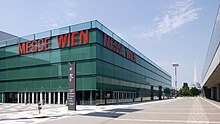 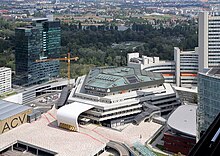 Vienna generates 25.1% of Austria's GDP, making it the highest performing regional economy of the country. It has a GDP per capita of €56,600€ as of 2024. The unemployment rate in Vienna is 9.6% as of 2022, which is the highest of all the states.[77] The private service sector provides 75% of all jobs.[78] The city improved its position from 2012 on the ranking of the most economically powerful cities reaching number nine on the list in 2015.[79][80] Of the top 500 Austrian firms measured by turnover, 203 are headquartered in Vienna.[78] As of 2015, 175 international firms maintained offices in Vienna.[81] Since the fall of the Iron Curtain in 1989, Vienna has expanded its position as a gateway to Eastern Europe. 300 international companies have their Eastern European headquarters in Vienna, including Hewlett-Packard, Henkel, Baxalta, and Siemens.[82] Research and developmentBioscience is a major research and development sector in Vienna. The Vienna Life Science Cluster is Austria's major hub for life science research, education and business. Throughout Vienna, five universities and several basic research institutes form the academic core of the hub with more than 12,600 employees and 34,700 students. Here, more than 480 medical device, biotechnology and pharmaceutical companies with almost 23,000 employees generate around 12 billion euros in revenue (2017). This corresponds to more than 50% of the revenue generated by life science companies in Austria (22.4 billion euros).[83][84][needs update] Vienna is home to Boehringer Ingelheim, Octapharma, Ottobock and Takeda Pharmaceutical Company.[85] Companies such as Apeiron Biologics, Hookipa Pharma, Marinomed, mySugr, Themis Bioscience and Valneva operate in Vienna.[86] The Central European Diabetes Association, a cooperative international medical research association, was founded in the city. Information technologiesThe Viennese sector for information and communication technologies is comparable in size with those of Helsinki, Milan, or Munich, and ranks among Europe's largest locations for information technology. In 2012 8,962 information technology businesses with a workforce of 64,223 were located in the Vienna region. Among the biggest IT firms in Vienna are Kapsch, Beko Engineering & Informatics, Frequentis, Cisco Systems Austria, Microsoft Austria, IBM Austria and Samsung Electronics Austria.[87][88] The British company UBM has rated Vienna one of the Top 10 Internet Cities worldwide, by analyzing criteria like connection speed, WiFi availability, innovation spirit and open government data.[89] ConferencesIn 2022, the International Congress and Convention Association (ICCA) ranked Vienna 1st in the world for association meetings.[90] The Union of International Associations (UIA) ranked Vienna 5th in the world for 2019 with 306 international meetings, behind Singapore, Brussels, Seoul and Paris.[91] The city's largest conference center, the Austria Center Vienna (ACV) has a total capacity for around 22,800 people and is situated next to the United Nations Office at Vienna.[92] Other centers are the Messe Wien Exhibition & Congress Center (up to 3,000 people) and the Hofburg Palace (up to 4,900 people). TourismThere were 17.3 million overnight stays in Vienna in 2023. The top ten incoming markets in 2023 were Germany, the rest of Austria, the United States, Italy, the United Kingdom, Spain, France, Poland, Switzerland, and Romania.[93] CultureClassical Music, theater, and opera Art and culture have had a long tradition in Vienna, including theater, opera, classical music and fine arts. The Burgtheater is considered one of the premier theaters in the German-speaking world alongside its branch, the Akademietheater. The Volkstheater and the Theater in der Josefstadt also enjoy good reputations. There is also a multitude of smaller theaters, in many cases devoted to less mainstream forms of the performing arts, such as modern or experimental plays, as well as cabaret. The city is also home to a number of opera houses, including the Theater an der Wien, the Staatsoper and the Volksoper, the latter being devoted to the typical Viennese operetta. Classical concerts are performed at venues such as the Wiener Musikverein, home of the Vienna Philharmonic Orchestra known across the world for its annual, widely broadcast "New Year's Concert", as well as the Wiener Konzerthaus, home of the internationally renowned Vienna Symphony. Many concert venues offer concerts aimed at tourists, featuring popular highlights of Viennese music, particularly the works of Wolfgang Amadeus Mozart, Johann Strauss I, and Johann Strauss II. Notable classical musicians born in Vienna include Louie Austen, Alban Berg, Fritz Kreisler, Joseph Lanner, Arnold Schoenberg, Franz Schubert, Johann Strauss I, Johann Strauss II and Anton Webern. 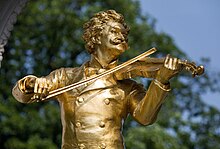 Famous classical musicians who moved to the city to work were Kurt Adler, Johann Joseph Fux, Joseph Haydn, Wolfgang Amadeus Mozart, Ludwig van Beethoven, Ferdinand Ries, Johann Sedlatzek, Antonio Salieri, Carl Czerny, Johann Nepomuk Hummel, Franz Liszt, Franz von Suppé, Anton Bruckner, Johannes Brahms, and Gustav Mahler. Operas that premiered in the capital include Fidelio, Die Fledermaus, The Gypsy Baron, The Magic Flute, and The Marriage of Figaro. Up until 2005, the Theater an der Wien hosted premieres of musicals, but since 2006 (a year dedicated to the 250th anniversary of Mozart's birth), has devoted itself to opera again, becoming a stagione opera house offering one new production each month. Since 2012, Theater an der Wien has taken over the Wiener Kammeroper, a historical small theater in the first district of Vienna seating 300 spectators, turning it into its second venue for smaller-sized productions and chamber operas created by the young ensemble of Theater an der Wien (JET). Before 2005 the most successful musical was Elisabeth, which was later translated into several languages and performed all over the world. The Wiener Taschenoper is dedicated to stage music of the 20th and 21st century. The Haus der Musik ("House of Music") opened in the year 2000. The Vienna's English Theater (VET) is an English theater in Vienna. It was founded in 1963 and is located in the 8th Vienna's district. It is the oldest English-language theater in continental Europe. 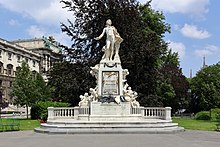 Popular MusicVienna has also produced some well-known pop music artists. Pioneers of Austropop, Georg Danzer, Rainhard Fendrich, Wolfgang Ambros, and Peter Cornelius all hail from the capital. Willi Resetarits lived in the city from the age of three. The internationally best-known Viennese artist was Falco, whose song ”Rock Me Amadeus” is the only German-language song to reach number 1 on the American Billboard Hot 100, which it held for three weeks in 1986. His other hits, such as “Der Kommissar” and “Jeanny” also charted internationally. The founder of the American jazz fusion band Weather Report and Miles Davis collaborator, Joe Zawinul, was born in Vienna and studied music at the Conservatory of Vienna.  Current artists include Rapper RAF Camora, who grew up in the district of Rudolfsheim-Fünfhaus and often emphasizes his ties to his home in his lyrics, as well as hip-hop-musician Yung Hurn and indie pop band Wanda. Multiple popular songs have been written about Vienna, such as "Vienna" (1977) by Billy Joel, "Vienna" (1981) by Ultravox, and "Vienna Calling" by Falco. The Wienerlied is a unique song genre from Vienna. They are sung in Viennese dialect and often center around the city. There are approximately 60,000 – 70,000 Wienerlieder. Every year the Donauinsel stages the Donauinselfest, the largest open-air music festival in the world, with approximately 3 million attendees over three days.[94] The festival is organized by the SPÖ Wien and is free to enter.[95] The Vienna Jazz Festival has taken place almost every year since 1991 and has featured artists such as Nina Simone, Miles Davis, Dizzy Gillespie, and Ravi Shankar. Cinema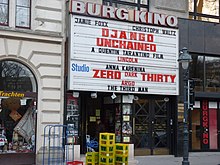 Films set in Vienna include Amadeus, Before Sunrise, The Third Man, The Living Daylights and Mission: Impossible – Rogue Nation. Notable actors born in the city include Hedy Lamarr, Christoph Waltz, Christiane Hörbiger, Eric Pohlmann, Boris Kodjoe, Christine Buchegger, Senta Berger and, Christine Ostermayer. Many filmmakers, such as Michael Haneke and Fritz Lang, and Billy Wilder, who lived in Vienna during his teenage years, were born in Vienna. Vienna's cinemas include the Apollo Kino and Cineplexx Donauzentrum and many English language cinemas, including the Haydn Kino, Artis International and the Burg Kino, which screens The Third Man, a 1949 film set in Vienna, three times a week. Every October since 1960 the city has staged the Viennale, an international film festival which screens several different genres of films and many premieres. LiteratureNotable writers from Vienna include Carl Julius Haidvogel, Karl Leopold von Möller, and Stefan Zweig. Writers who lived and worked in Vienna include Ingeborg Bachmann, Thomas Bernhard, Elias Canetti, Ernst von Feuchtersleben, Elfriede Jelinek, Franz Kafka, Karl Kraus, Robert Musil, Arthur Schnitzler, and Bertha von Suttner. Science Scientists and intellectuals who were born, lived or worked in Vienna include:
Museums The majority of museums in Vienna are located in an area on the border of Innere Stadt and Neubau in the center of the city, from the museums inside the Hofburg to the MuseumsQuartier, with the twin Naturhistorisches Museum and Kunsthistorisches Museum in between. This area is home to many museums such as:
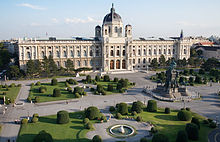

The Österreichische Galerie Belvedere at the Belvedere presents art from Austria from the Middle Ages through the Baroque to the early 20th century, including The Kiss, Gustav Klimt's most famous work. It also houses the Baroque Museum with Franz Xaver Messerschmidt's famous character heads. In 2011, Belvedere 21 (formerly 21er Haus) was reopened in its immediate vicinity as a branch of contemporary art.  The Vienna Museum documents the history of Vienna with temporary exhibitions and a permanent presentation and presents the memorials to Ludwig van Beethoven, Joseph Haydn, Wolfgang Amadeus Mozart, Franz Schubert and Johann Strauss. Other branches of the museum include the Hermesvilla in the Lainzer Tiergarten, the Vienna Clock Museum, the Roman Museum and the Prater Museum. The former imperial summer residence at Schönbrunn Palace, Vienna's most visited attraction, is set up as a museum with the palace's showrooms and the Imperial Carriage Museum. The Museum of Military History in the Arsenal is the leading museum of the Austrian Armed Forces and documents the history of the Austrian military with exhibits including weapons, armour, tanks, aircraft, uniforms, battle flags, paintings, medals and decorations, photographs, battleship models and documents.  Other museums in the city include:
Architecture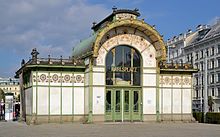 A variety of architectural styles have been preserved in Vienna, including Romanesque and Baroque architecture. Art Nouveau has left many architectural traces in Vienna. The Secession building, Karlsplatz Stadtbahn Station, and the Kirche am Steinhof by Otto Wagner rank among the best-known examples of Art Nouveau in the world. The Wiener Moderne shunned the use of extraneous adornment. Architect Adolf Loos is responsible for the Looshaus (1909), the Kärntner Bar (1908), and the Steiner House (1910). The Hundertwasserhaus by Friedensreich Hundertwasser, designed to counter the clinical look of modern architecture, is one of Vienna's most popular tourist attractions. Hundertwasser also designed the KunstHausWien and the District Heating Plant in Alsergrund. In the 1990s, a number of quarters were adapted and extensive building projects were implemented in the areas around Donaustadt and Wienerberg. Vienna has seen numerous architectural projects completed which combine modern architectural elements with old buildings, such as the remodeling and revitalization of the old Gasometer in 2001. 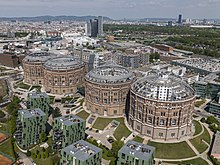 The DC Towers are located on the northern bank of the Danube and were completed in 2013.[96][97] Places of worship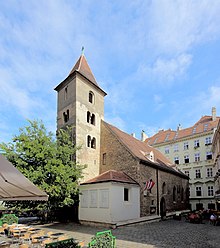 Due to the prevalence of Christianity in the city, most places of worship are churches and cathedrals. Most notable are:
Other notable churches include the Augustinian Church, the Church of St. Maria Rotunda, the Church of St. Leopold, the Franciscan Church, the Jesuit Church and the Minoritenkirche. Vienna's biggest mosque is the Vienna Islamic Center in Kaisermühlen, which is financed by the Muslim World League. The mosque features a 32-meter-high minaret and a dome 16 meters high, with a 20-meter radius.[98] In addition, there are over 100 further mosques in the city.[99] Before the November pogroms of 1938, also known as the Kristallnacht, Vienna had 24 synagogues and 78 prayer houses. Only one synagogue, the Stadttempel, survived the destruction.[100] Ball dancesThe first balls in Vienna were held in the 18th century. The ball season takes place annually during Carnival, running from 11 November to Shrove Tuesday. Many balls are held in the Hofburg, Rathaus and Musikverein. Guests adhere to a strict dress code, men are required to wear black or white tie, while women must wear ball gowns. Debutants of the ball wear white.[101] The balls are opened with dances, traditionally including a Viennese waltz, at around 22:00, and close at about 05:00 the next morning. Food served at the balls includes sausages with bread, and goulash. Notable Viennese balls include the Vienna Opera Ball, the Vienna Ball of Sciences, the Wiener Akademikerball and the Hofburg Silvesterball. The Wiener Akademikerball in the Hofburg has attracted lots of controversy for being a gathering for far-right politicians and groups. The ball is hosted by the FPÖ, the right-wing populist party of Austria and has attracted multiple right-wing and far-right personalities, such as Martin Sellner and Marine Le Pen. Since 2008, annual demonstrations organized by various groups have protested against the event. Former leader of the FPÖ Heinz-Christian Strache compared anti-fascist protesters to a Nazi mob, alleging that the ball attendees were being treated as "new Jews".[102][103] LanguageVienna is part of the Austro-Bavarian language area, in particular Central Bavarian (Mittelbairisch).[104] The Viennese dialect takes many loanword from languages of the former Habsburg Monarchy, especially Czech. The dialect differs from the west of Austria in its pronunciation and grammar. Features typical of Viennese German include Monophthongization, the transformation of a diphthong into a monophtong (German heiß (hot) into Viennese haas) and the lengthening of vowels (Heeaasd, i bin do ned bleeed, wooos waaasn ii, wea des woooa (Standard German Hörst du, ich bin doch nicht blöd, was weiß denn ich, wer das war): "Listen, I'm not stupid; what do I know, who that was?"). Speakers of the dialect tend to avoid the genetive case.[105] LGBT Vienna is regarded as the center of LGBTQ+ life in Austria.[106] The city has implemented an action plan against homophobic discrimination and has maintained an anti-discrimination unit within its administration since 1998.[107] The city has several cafés, bars and clubs frequented by the LGBTQ+ community, including the Café Savoy, a traditional coffee house established in 1896. In 2015, Vienna introduced traffic lights featuring same-sex couples before hosting the Eurovision Song Contest that year, which garnered media attention internationally.[108] Multiple rainbow crossings are dotted around the city. Vienna's Pride Parade is held every June. In 2019, when the parade hosted Europride, it attracted around 500.000 visitors.[109] EducationSchools As of the 2022/2023 school year, there were 457 compulsory education schools in Vienna, including 303 primary schools and 140 middle schools. Additionally, there are 98 high schools, 90 of which also include middle school education. Around 250,000 children are enrolled in the Viennese school system, which is staffed by almost 29,000 teachers.[48] Universities With 197,209 students enrolled in the winter semester 2023/2024, Vienna has the largest student population of any city in the German-speaking world.[110][48] Vienna is home to several historic universities. The University of Vienna, the oldest and largest in the German-speaking world, was founded in 1365 by Duke Rudolph IV. Its medical faculty became independent as the Medical University of Vienna in 2004. Other prominent institutions include the Academy of Fine Arts Vienna (1692), the University of Veterinary Medicine Vienna (1765), and the University of Music and Performing Arts Vienna (1767). The 19th century saw the founding of the Vienna University of Technology (TU), the University of Natural Resources and Life Sciences (BOKU) and the Vienna University of Economics and Business (WU). The University of Applied Arts, established in 1867, gained university status in 1970 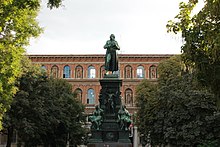 In addition to these public universities, Vienna also hosts several private universities, including the Webster Vienna Private University, the Music and Arts University of the City of Vienna and, since 2019, the Central European University, as well as several universities of applied sciences. International schoolsDue partly to the numerous international offices in the city, Vienna is home to many international schools, including the Vienna International School, the American International School, the International Christian School and the Lycée Français de Vienne. Green spacesParks On the southeastern outer border of the Ringstraße is the Stadtpark. The park covers an area of about 28 acres and is split in half by the Wien river. It contains monuments to various Viennese artists, most notably the gilded bronze monument of Johann Strauß II.[111] On the other side of the Ring is the Burggarten, just behind the Hofburg, which features a monument to Mozart as well as a greenhouse. On the other side of the Hofburg is the Volksgarten, home to a small-scale replica of the Temple of Hephaestus and a cultivated flower garden. On the other side of the road, in front of the Rathaus, is the Rathauspark, which hosts the Christmas Christkindlmarkt. 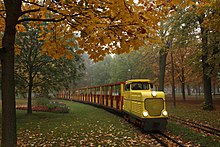 The Prater is a large public park in Leopoldstadt. Within the park is the Wurstelprater (colloquially known as “the Prater”), a public amusement park that contains the Wiener Riesenrad, a 64.75 meter tall Ferris Wheel, along with various rides, roller coasters, carousels and a Madame Tussauds.[111] The rest of the park is covered by forest. The Hauptallee, a wide, car-free alley lined with horse chestnut trees, runs through the park.[112] Eliud Kipchoge broke the marathon distance record on this road in the INEOS 1:59 Challenge in October 2019.[113] The Prater also is home to the Liliputbahn, a railway line primarily used by tourists, and a planetarium.[114][115] It was the location of the 1873 Vienna World's Fair.[116] In 1931, the Ernst-Happel-Stadion, formerly known as the Praterstadion, was opened in the Prater.[117][118] 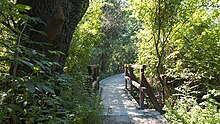 The Lobau, a floodplain in the southeast of the city, is a part of the wider Danube-Auen National Park. It is used for recreation and has many nudist areas. It is home to multiple species of animals:[119]
In the west of the city is the Lainzer Tiergarten, a 24.5 km² public nature reserve, of which 19.5 km² is woodland.[120] The park was created in 1561 by Emperor Ferdinand I, who used it as a private hunting ground. After the fall of the monarchy, the Austrian government declared it a public nature reserve. Since 1973, admission has been free of charge. The reserve is home to many wild boar, fallow deer, red deer, European mouflons, as well as 18 species of bats.[121] The grounds of the imperial Schönbrunn Palace contain an 18th-century park which includes the Schönbrunn Zoo, which was founded in 1752, making it the world's oldest zoo still in operation.[122] The zoo is one of the few to house giant pandas.[123] The park also features the Palmenhaus Schönbrunn, a large greenhouse with around 4,500 plant species.  The Augarten in Leopoldstadt, on the border of Brigittenau, is a 129-acre French Baroque-style public park open during the day. The park is home to flower gardens and multiple tree-lined avenues. The park was opened in 1775 by Joseph II and is surrounded by a wall with five gates, which are shut at night. The baroque Palais Augarten, in the south of the park, is home to the Vienna Boys' Choir. Towering over the park are two anti-aircraft flak towers, built by the Nazis in 1944. After the war, as the towers were unable to be destroyed, so they were left standing. They now stand empty and serve no function, though various other such towers in the city were repurposed, such as the Haus des Meeres in Esterhazy Park. The Donauinsel, part of Vienna's flood defences, is a 21.1 km (13.1 mi) long artificial island between the Danube and New Danube dedicated to leisure activities. It was constructed from 1972 to 1988 for flood protection measures.[124] Sporting amenities, such as volleyball courts, playgrounds, skate spots, dog parks, and multiple toilet facilities, some with showers, are available on the island. To transform the island into a green space, approximately 1.8 million trees and shrubs, along with 170 hectares of forest, were planted.[125] A few hundred Japanese cherry trees were planted as a symbol of friendship between Austria and Japan. Animals on the island include sand lizards and Danube crested newts.[126] 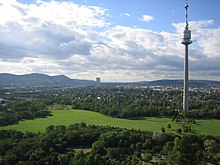 The Donaupark is a 63-hectare park in Kaisermühlen, Donaustadt, between the New Danube and the Old Danube, next to the Vienna International Centre. The park features the Donauturm, the tallest structure in Austria at 252 meters, as well as a 40-meter tall steel cross, erected in 1983 on the occasion of a holy mass held by Pope John Paul II during his visit to Austria. In the park is the Latin America-Caribbean Square, which features memorials to multiple Latin American figures such as Salvador Allende, Simón Bolívar, and Che Guevara. Other parks include the Türkenschanzpark, the Schweizergarten, and the Waldmüllerpark. Cemeteries Vienna is home to 55 cemeteries, 46 of which are run by the city, the others by religious communities.[127] The biggest cemetery in the city is the Vienna Central Cemetery (Zentralfriedhof). It is 2.4 km² large with over 330,000 graves and about 3,000,000 interments. It was opened in 1874 and contains Catholic, Protestant, Muslim and Jewish sectors. Notable interments include Ludwig van Beethoven, Falco, Bruno Kreisky, Hedy Lamarr, as well as every deceased president since WWII. Deer, badgers, martens, and, most notably, European hamsters roam the park, eating the plants growing around the headstones. There are numerous memorials on the cemetery grounds, such as for the casualties of the Revolutions of 1848 and the July Revolt of 1927, and for the victims of the Nazi regime. The now closed St. Marx Cemetery contains the grave of Wolfgang Amadeus Mozart. Others include the cemeteries of Grinzing and Hietzing, as well as the Jewish cemetery in Roßau. DanubeVienna is the largest city on the Danube, which runs from the north, through the city, and out the south-east. In Vienna, the river is split into 4 parts:
SportFootball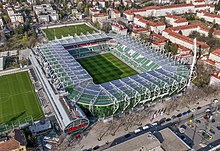 The city is home to numerous football clubs. The two biggest teams are FK Austria Wien (21 Austrian Bundesliga titles and record 27-time cup winners), who play at the Generali Arena in Favoriten, and SK Rapid Wien (record 32 Austrian Bundesliga titles), who play at the Allianz Stadion in Penzing. The oldest team in Austria, First Vienna FC, and Floridsdorfer AC both play in the 2. Liga, and the football team of the Wiener Sport-Club, one of the oldest athletics clubs in the country, play in the Austrian Regionalliga East, the third division. 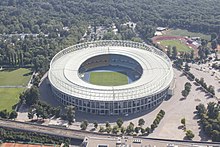 The Ernst-Happel-Stadion is the largest stadium in Austria with 50,865 seats and is the home stadium of the Austria national football team. It has hosted multiple European Cup finals (1963–64, 1986–87, 1989–90, 1994–95), as well as seven games at the 2008 Euros, including the final, which saw a Spanish 1–0 victory over Germany. Other sportsOther sports clubs include the Vikings Vienna (American football), who won the Eurobowl title 4 times in a row between 2004 and 2007 and had a perfect season in 2013. The Hotvolleys Vienna (volleyball), the Vienna Wanderers (baseball), who won the 2012 and 2013 Championship of the Austrian Baseball League, and the Vienna Capitals (ice hockey). European Handball Federation (EHF) is headquartered in Vienna. There are also three rugby clubs in the city; Vienna Celtic, the oldest rugby club in Austria, RC Donau, and Stade Viennois.  In addition to team sports, Vienna also offers a wide range of individual sports. The paths in the Prater or on the Donauinsel are popular running routes. The Vienna City Marathon, which attracts more than 10,000 participants every year, typically takes place in May. Cyclists can choose from over 1,000 kilometers of cycle paths and numerous mountain bike trails in the Viennese mountains. Golf courses are available on the Wienerberg or in the Prater. The Vienna Open tennis tournament has taken place in the city since 1974. The matches are played on indoor hardcourts in the Wiener Stadthalle. The City of Vienna also operates two ski slopes on Hohen-Wand-Wiese and on the Dollwiese. Culinary specialitiesFood Vienna is well known for Wiener schnitzel, a cutlet of veal (Kalbsschnitzel) (sometimes also made with pork (Schweinsschnitzel) or chicken (Hühnerschnitzel)) that is pounded flat, coated in flour, egg and breadcrumbs, and fried in clarified butter. It is available in almost every restaurant that serves Viennese cuisine and can be eaten hot or cold. The traditional 'Wiener Schnitzel' though is a cutlet of veal. Other examples of Viennese cuisine include Tafelspitz (very lean boiled beef), which is traditionally served with Geröstete Erdäpfel (boiled potatoes mashed with a fork and subsequently fried) and horseradish sauce, Apfelkren (a mixture of horseradish, cream and apple) and Schnittlauchsauce (a chives sauce made with mayonnaise and stale bread). Vienna has a long tradition of producing cakes and desserts. These include Apfelstrudel (hot apple strudel), Milchrahmstrudel (milk-cream strudel), Palatschinken (sweet pancakes), and Knödel (dumplings) often filled with fruit such as apricots (Marillenknödel). Sachertorte, a delicately moist chocolate cake with apricot jam created by the Sacher Hotel, is world-famous. 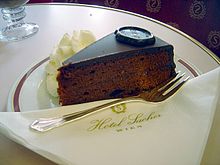 In winter, small street stands sell traditional Maroni (hot chestnuts) and potato fritters. Sausages are popular and available from street vendors (Würstelstand) throughout the day and into the night. The sausage known as Wiener (German for Viennese) in the U.S. and in Germany, is called a Frankfurter in Vienna. Other popular sausages are Burenwurst (a coarse beef and pork sausage, generally boiled), Käsekrainer (spicy pork with small chunks of cheese), and Bratwurst (a white pork sausage). Most can be ordered "mit Brot" (with bread) or as a "hot dog" (stuffed inside a long roll). Mustard is the traditional condiment and usually offered in two varieties: "süß" (sweet) or "scharf" (spicy). Vienna ranked 10th in vegan friendly European cities in a study by Alternative Traveler.[131] The Naschmarkt is a permanent market for fruit, vegetables, spices, fish, and meat. Drinks Vienna, along with Barcelona, Bratislava, Canberra, Cape Town, Paris, Prague, Santiago and Warsaw, is one of the few remaining world capital cities with its own vineyards.[132] The wine is served in small Viennese pubs known as Heuriger. The wine is often drunk as a Spritzer ("G'spritzter") with sparkling water. The Grüner Veltliner, a dry white wine, is the most widely cultivated wine in Austria.[133] Another wine very typical for the region is "Gemischter Satz", which is typically a blend of different types of wines harvested from the same vineyard.[134] Beer is next in importance to wine. Vienna has a single large brewery, Ottakringer, and more than ten microbreweries. Ottakringers' most popular drink is the Ottakringer Helles, a beer with an alcohol content of 5.2%. A "Beisl" is a typical small Austrian pub, of which Vienna has many. Local soft drinks such as Almdudler are popular around the country as an alternative to alcoholic beverages, placing them on the top spots alongside American counterparts such as Coca-Cola in terms of market share. Other popular drinks are the Spezi, a mix between cola and orange lemonade, and Frucade, a German carbonated orange drink. Viennese cafés The Viennese coffee house (Kaffeehaus) dates back to the Austro-Hungarian empire. The Vienna intelligentsia treated Viennese cafés like a living room.[135] The first Viennese café was opened in 1685 by Armenian businessman Johannes Diodato. Café culture flourished in Vienna in the early 19th century.[136] Notable patrons included political figures Joseph Stalin, Adolf Hitler, Leon Trotsky and Josip Broz Tito, who all lived in Vienna in 1913, as well as scientists, writers and artists such as Sigmund Freud, Stefan Zweig, Egon Schiele and Gustav Klimt.[137] Notable coffee houses include:
Heuriger Vienna is one of the few major cities with its own wine-growing region. This wine is sold in taverns, so-called Heuriger, by the local winemakers during the growing season. The wine is often served as a Schorle, a mix of wine and carbonated water. The meals are simple and homemade, usually consisting of fresh bread, typically semmels, with local coldcuts and cheese, or Liptauer spread. The Heurigers are especially numerous in the areas of Döbling (Grinzing, Neustift am Walde, Nußdorf, Salmannsdorf, Sievering), Floridsdorf (Stammersdorf, Strebersdorf), Liesing (Mauer) and Favoriten (Oberlaa).[138] TransportPublic transportVienna has an extensive public transportation network. It consists predominantly of the Wiener Linien network (subway, tram and bus lines) and the S-Bahn lines belonging to the Austrian Federal Railways (ÖBB). As of 2023, 32% of the population of the city uses public transit as their main mode of transit.[139]  U-BahnThe Vienna metro system consists of five lines (U1, U2, U3, U4, U6) with the U5 currently under construction. The metro currently serves 98 stations and covers a distance of 83.5 kilometers.[140] The services run from 05:00 to about 01:00 with intervals of two to five minutes during the day and up to eight minutes after 20:00. On Friday and Saturday evenings and on evenings before a public holiday they operate a 24-hour service at 15-minute intervals.[141]
Buses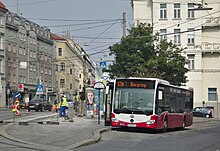 Buses were first introduced to the city in 1907. Currently, 117 bus lines operate in Vienna during the day. 47 of these are run by the Wiener Linien, who also set the routes and timetables, the rest by subcontractors such as Dr. Richard, Gschwindl and Blaguss. The Wiener Linien also operate 20 night buses.[142] Trams The Viennese tram network has existed since 1865; the first line was electrified in 1897. There are currently 28 lines with 1071 stops that operate on a network of 176,9 km. The trams move at about 15 km/h. The fleet consists of both high-floor and low-floor vehicles, however the high-floor models, which are not air-conditioned, are in the process of being replaced by more modern, accessible trams. The modern models are air-conditioned and suitable for disabled users.[143][144] Trains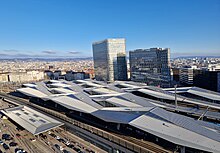 The city forms the hub of the Austrian railway system, with services to all parts of the country and abroad. The railway system connects Vienna's main station Vienna Hauptbahnhof with other European cities, including Bratislava, Budapest, Ljubljana, Munich, Prague, Venice, Wrocław, Warsaw, Zagreb, and Zürich. Other train stations include:
Cycling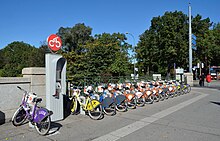 The cycling network in the city spans 1.721 kilometers, however, this figure counts bidirectional bike paths twice and includes on-road cycle-lanes which are also shared with motor vehicles.[145] The network is constantly being expanded and upgraded, especially in the outer areas, such as Donaustadt.[146] Bike use in the city has been rising, from just 3% in 1993 to 10% in 2023.[139] The city operates a bicycle-sharing system, WienMobil Radverleih, with 3000 bikes at 185 station, available at all times. The bikes are 7-speed city bikes with an adjustable saddel. Airport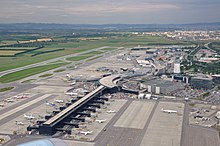 Vienna is served by Vienna International Airport, located 18 km southeast of the city center near the town of Schwechat. The airport handled approximately 29.5 million passengers in 2023.[147] Following lengthy negotiations with surrounding communities, the airport will be expanded to increase its capacity by adding a third runway. The airport is undergoing a major expansion, including a new terminal building that opened in 2012 to prepare for an increase in passengers. Another possibility is to use Bratislava Airport, Slovakia, located approximately 60 km away. Viennese peopleInternational relationsInternational organizations in Vienna In 1980 Vienna became a UN headquarters, alongside New York City and Geneva, later joined by Nairobi. The city hosts many international organizations, many of them in the Vienna International Centre in Donaustadt, including:
 In addition, the University of Vienna hosts the annual Willem C. Vis Moot, an international commercial arbitration competition for students of law from around the world. Diplomatic meetings were often held in Vienna in the latter half of the 20th century, resulting in multiple documents bearing the name Vienna Convention. Among the more important documents negotiated in Vienna are the 1969 Vienna Convention on the Law of Treaties, as well as the 1990 Treaty on Conventional Armed Forces in Europe. Vienna also hosted the negotiations leading to the 2015 Joint Comprehensive Plan of Action on Iran's nuclear program as well as the Vienna peace talks for Syria. Charitable organizations in ViennaAlongside international and intergovernmental organizations, there are dozens of charitable organizations based in Vienna. One such organization is the network of SOS Children's Villages, founded by Hermann Gmeiner in 1949. Today, SOS Children's Villages are active in 132 countries and territories worldwide. Others include Help Afghan School Children Organization (HASCO). International city cooperationsThe general policy of the City of Vienna is not to sign any twin town agreements with other cities. Instead Vienna has only cooperation agreements in which specific cooperation areas are defined.[148] District to district partnershipsIn addition, individual Viennese districts have international partnerships all over the world. A detailed list is published on the website of the City of Vienna.[149] See alsoNotesReferences
Further reading
External linksOfficial websites
History of Vienna
Further information on Vienna
|
|||||||||||||||||||||||||||||||||||||||||||||||||||||||||||||||||||||||||||||||||||||||||||||||||||||||||||||||||||||||||||||||||||||||||||||||||||||||||||||||||||||||||||||||||||||||||||||||||||||||||||||||||||||||||||||||||||||||||||||||||||||||||||||||||||||||||||||||||||||||||||||||||||||||||||||||||||||||||||||||||||||||||||||||||||||||||||||||||||||||||||||||||||||||||||||||||||||||||||||||||||||||||||||||||||||||||||||||||||||||||||||||||||||||||||||||||||||||||||||||||||||||||||||||||||||||||||||||||||||||||||||||||||||||||||||||||||||||||||||||||||||||||||||||||||||||||||||||||||||||||||||||||||||||||||||||||||||||||||||||||||||||||||||||||||||||||||||||||||||||||||||||||||||||||||||||||||||||||||||||||||||||||||||||||||||||||||||||||||||||||||||||||||||||||||||||||||||||||||||||||||||||||||||||||||||||||||||||||||||||||||||||||||||||||||||||||||||||||||||||||||||||||||||||||||||||||||||||||||||||||||||||||||||||||||||||||||||||||||||||||||||||||||||||||||||||||||||||||||||||















































